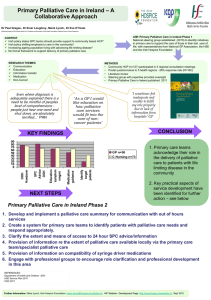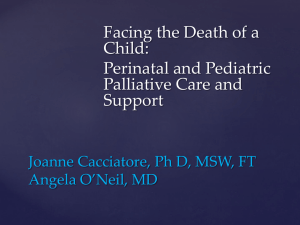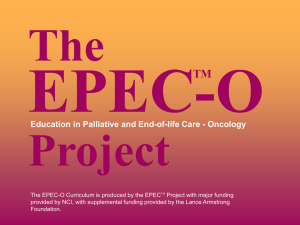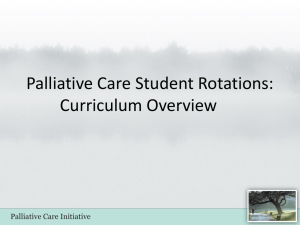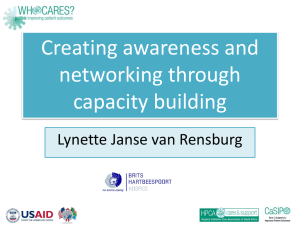Palliative Care Survey for Program Leaders - Results
advertisement
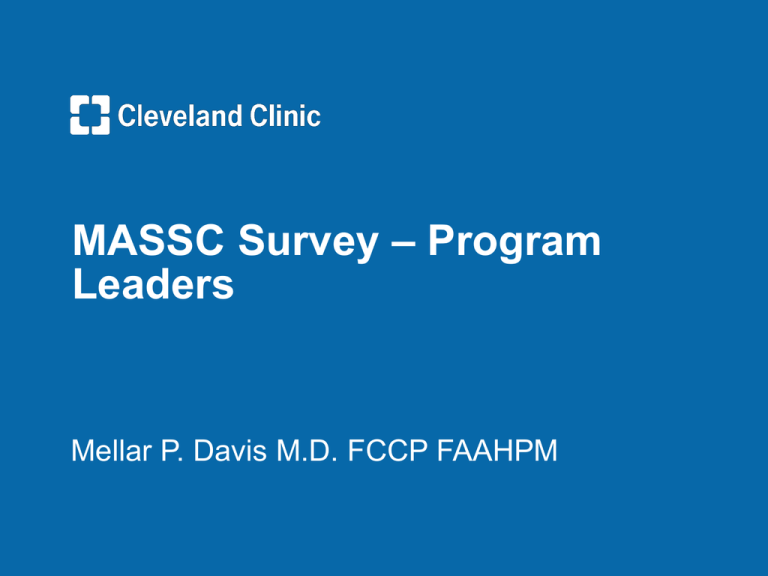
MASSC Survey – Program Leaders Mellar P. Davis M.D. FCCP FAAHPM Format • Questions 4-25, 39, 44, 49, 51, 54-60, 62-65 pertain to all programs. • Questions 26-38 pertain to programs with dedicated (nonhospice) acute care beds. • Questions 40-43 pertain to programs with a dedicated consultation service. • Questions 45-48 pertain to programs that see patients in an outpatient setting Format • Question 50 pertains to programs that have a hospice program. • Questions 52-53 pertain to programs with palliative medicine fellowship programs. • Question 61 pertains to programs that have palliative care grand rounds. • Questions 66-81 pertain to programs that have a research program. Note that questions 76-81 appear to pertain to all programs however question 65 ends the survey if the program does not conduct research. Results • 62 program leaders completed the survey • Program names were most often described using a single phrase (Question 2) – “Palliative care”, 22/61 (36%) • • • • • “Comprehensive cancer care”, 5/61 (8%) “Pain and symptom management”, 3/61 (3%) “Supportive care” 2/61 (3%) An unlisted phrase,5/61 (8%) 39% of programs were described using two or more phrases Results • The majority of programs were recorded as being more than five years old (43/61, 70%); 3 (5%) were recorded as being less than one year old; 4 (7%) as being 1-2 years old, and 11 (18%) as being 3-5 years old. • Responses are reported for all leaders combined and broken down by whether the program is relatively new (<5 years old) or mature (>5 years old). What are the specific kinds of palliative care services that are available? What are the type (s) of services that your palliative care team offers? Results • Other than in-house hospice the majority of programs offer all of the services described in questions 4 and 5, with 49% of programs offering consultation/mobile team service, supportive care clinics, and dedicated PC acute care beds (Q4); 59% of programs offered 7-8 of the specific services listed in Q5 Approximately, what proportion of patients seen by palliative care belong to the pediatric age group (<18 year old)? Results • Approximately 1/3 (34%) of programs see pediatric patients What is the professional background of the palliative care program leader? Results • The professional background of program leaders is quite varied. The most commonly recorded specialty was medical oncology (74%). 69% of respondents recorded >1 specialty Within your program, please indicate the approximate number of paid personnel assigned to palliative care Results • 48% of programs reported having >5 ward (inpatient) nurses assigned to PC; 10% reported having >5 clinic (outpatient) nurses assigned to PC • The majority of programs have at least one chaplain, dietitian, mid-level provider, rehabilitation personnel, psychologist, and social worker assigned to PC, but no pharmacists or psychiatrists Approximately, how many full-time equivalent (FTE) physician positions are available in your palliative care program? Approximately, how many physicians on your palliative care team have at least 20% academic protected time? Does your palliative care program require physicians to be certified (finished a fellowship and taken boards)? Does your palliative care program require nurses to be certified (taken boards in palliative nursing)? Results • Programs reported a median (range) of 2 (0-15) FTE physicians available for PC; over half (55%) the programs reported that at least some physicians have >20% academic protected time • The majority of programs (58%) required physicians to be certified (finished a fellowship and passed boards) and 53% required nurses to be certified On average, how long does your palliative care team follow patients in your institution (all inpatient and outpatient encounters)? Results • 43% of programs followed patients throughout the course of their illness Does your palliative care program have any dedicated acute care beds in your institution Results • Almost 3/4 (74%) of programs reported having dedicated (non-hospice) acute care beds; median (range) number of beds - 10 (0-43) • Almost 3/4 (74%) of these programs had a designated PC unit • Within these programs the median (range) number of inpatient discharges/month was 24 (2-250); and the median length of stay was 10 days (range 3-98) Results • The median (range) inpatient PC mortality rate within these programs was 40% (2-99%) • Acute symptom management was the primary reason for admission. Program leaders reported a median of 60% (range 0-90%) of admissions were for symptom management • The primary referral sources were outpatient clinics (median 25%; range 0-90%)), and inpatient units other than intensive care (median 20%; range 0-100%) Results • >75% of patients received regular psychosocial assessments on each admission in 55% of programs; • >75% of patients had family conferences in 50% of the programs; • Oncologists attended >75% of family conferences in 36% of programs; • >75% of patients had standing DNR orders in 51% of programs Does your palliative care program have a dedicated consultation service in your institution? Results • The vast majority (92%) of programs had dedicated consultations services • The service was available 24/7 in 43% of programs • A median (range) of 25 (3-400) referrals were made to the service monthly • The most common referral sources were medical and radiation oncology, and surgery Does your palliative care program see patients in the outpatient setting? Results • 90% of programs saw patients in an outpatient setting (primarily dedicated PC units) • Outpatient clinics were held a median (range) of 5 (0.5-7) days a week and a median (range) of 30 (3250) referrals/month were made to it • Similar to consultation services the most common referral sources were medical and radiation oncology, and surgery Does your institution operate a hospice? Results • 23% of programs operated a hospice Fellowship program for Palliative Medicine? Results • A little over 1/3 (37%) of programs had a fellowship program for palliative medicine. • Most of these programs (52%) had 1-2 clinical fellows/year; 56% had 1-2 research fellows/year Mandatory palliative care rotations for… Results • When applicable the majority of programs (56%) required PC rotations for medical oncology and hematology fellows; • 33% required them for radiation oncology fellows; • 9% required them for pediatric oncology fellows; • 51% required them for other fellows/residents; • 35% required them for medical students Training of mid-level providers in palliative care Results • Most programs (61%) trained mid-level providers Dedicated palliative care grand rounds Results • A little over 1/2 the programs (53%) held PC grand rounds – 68% held 1/week and 32% held 2-3/week Length of training for fellows for certification Results • Slightly less than 1/2 the programs (48%) had recognized accreditation requirements in order to be recognized as a PC specialist Is there a research program in palliative care Results • 64% of leaders reported having a PC research program • The research team most frequently consisted of physicians (100%), data analysts (75%), research nurses (72%), and/or psychologists (56%). 44% of the teams were fully staffed in the sense that they consisted of physicians, data analysts, research nurses and psychologists/social workers + other personnel Results • 62% of the research programs received outside funding – primarily from private foundations and philanthropy • 86% of programs conducted prospective studies, 57% conducted retrospective studies, 51% reported case series/reports, and 54% conducted qualitative studies Results • Research programs reported their results in PC and oncology journals, as well as more general medical journals (70% of programs had at least one publication in a PC journal last year; 68% had at least one in an oncology journal; and 49% had at least one in a general medical journal) “Young” versus “Mature” Programs • The number of newer programs is relatively small and therefore comparisons need to be viewed cautiously • Several differences that are perhaps worth noting include: “Young” versus “Mature” Programs • The professional backgrounds of the leaders from younger programs tended to be oncology based (medical/radiation oncology) more frequently than those of mature programs • Among programs with dedicated acute care beds length of stay tended to be shorter in mature programs compared to younger programs (median (range) 9.5 (3-96) versus 14.5 (9-98) days, respectively, p=007) “Young” versus “Mature” Programs • Among programs with dedicated consultation services mature programs tended to have more referrals/month than younger programs (median (range) 30 (3-400) vs 15 (4-40), respectively, p=.04); however this may be an artifact of the size of the programs? • Mature programs tended to require PC rotations for non-oncology fellows and residents more frequently than younger programs (60% vs 20%, p=.04); however this could be an artifact of the type of PC programs in each group?
